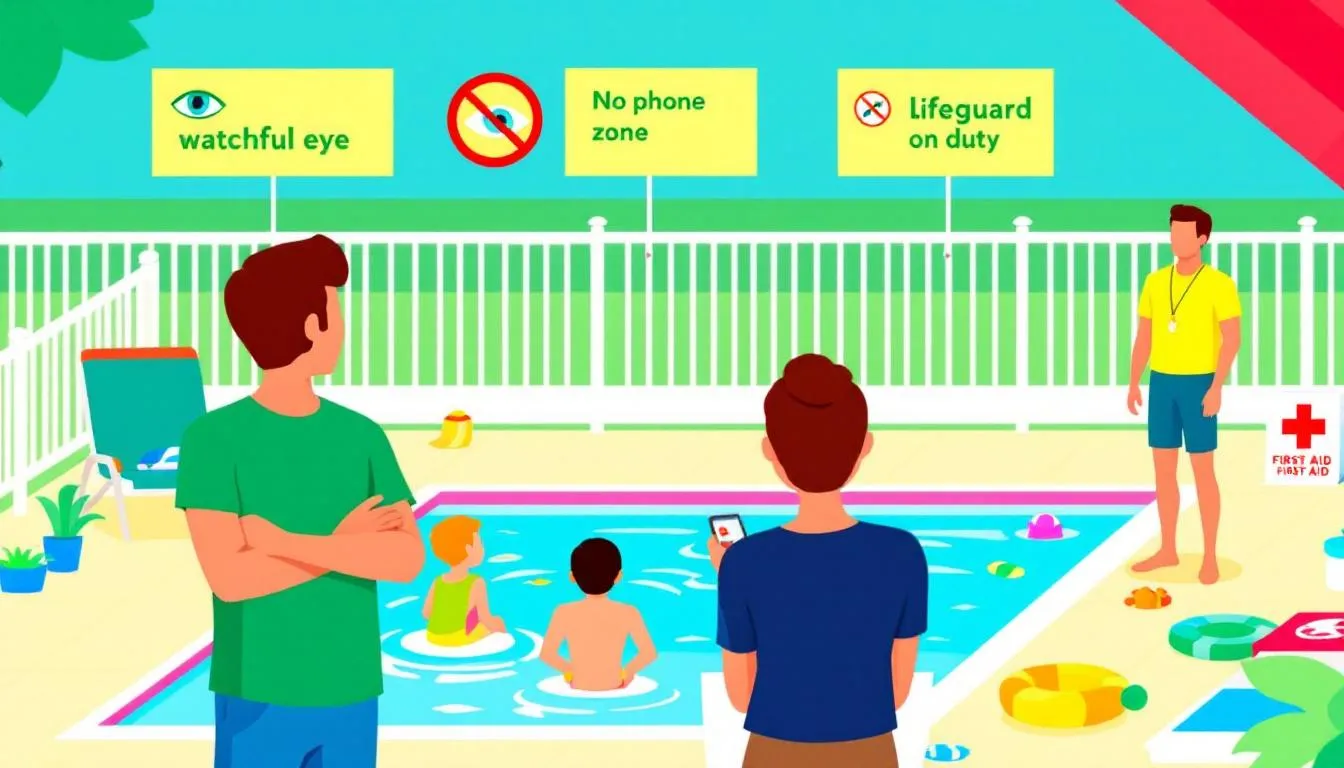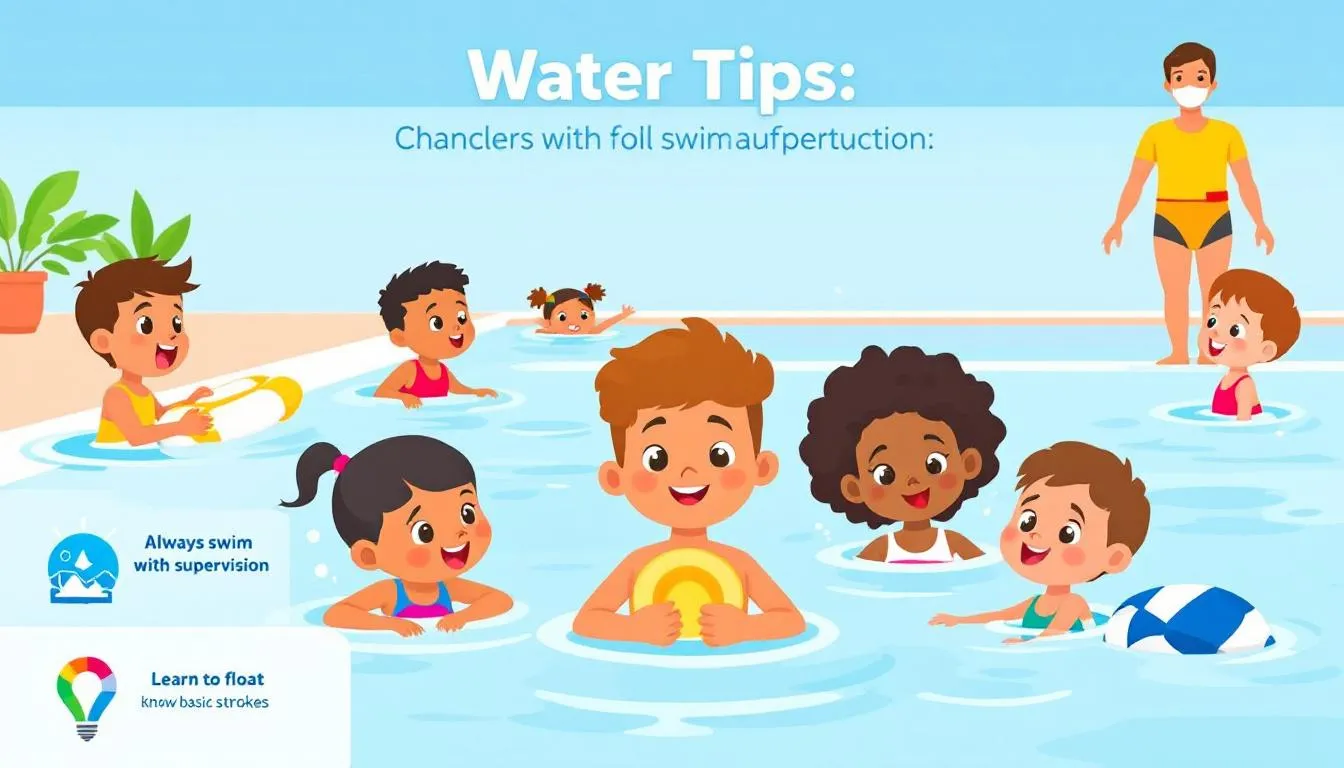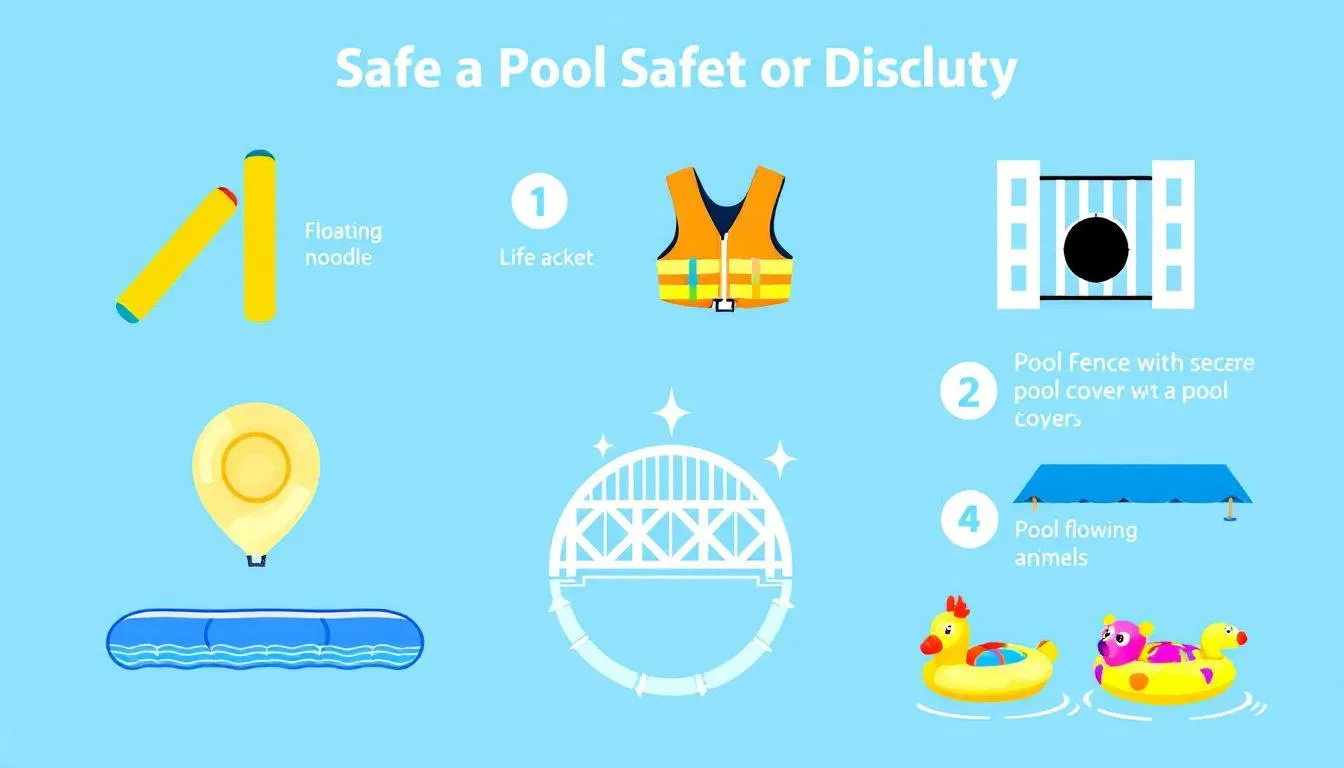
The Ultimate Guide to Residential Swimming Pool Safety: Protecting Your Home and Loved Ones
Key Takeaways
Implement key safety measures such as pool fences, covers, and alarms to create a secure swimming environment and minimize drowning risks.
Constant supervision and strategies like the ‘Arms Reach’ rule and buddy system are essential for ensuring safety around residential pools.
Educating children through swim lessons and engaging parental involvement significantly enhances water safety awareness and reduces the risk of drowning.
Essential Safety Measures for Residential Swimming Pools

Creating a safe swimming environment in residential pools requires implementing several key safety measures. Pool owners should start with installing pool fences, using pool covers, and setting up pool alarms. These measures form the first line of defense against unauthorized access and potential drownings, significantly reducing risks for toddlers and children.
These elements help create a secure environment for family and friends, making pools a safer place to enjoy.
Pool Fences
A pool fence is a critical component in preventing unauthorized access to the swimming pool, especially for young children who might wander into the pool area unnoticed. Important features of a pool safety fence include:
A standard height of four feet, which is high enough to deter children from climbing over it.
Gaps in the fence should not exceed four inches to prevent small children and pets from slipping through.
Safety gates that are self-closing and equipped with a self-locking latch to ensure the pool remains inaccessible when not in use.
Regularly inspecting the pool fence for gaps or openings helps maintain its integrity and ensures safety.
The cost of installing a pool safety fence can vary, often ranging upwards of $1,000, but this investment is invaluable when considering the safety it provides. Adhering to these guidelines ensures a reliable barrier, significantly reducing the risk of drowning incidents.
Pool Covers
Pool covers are another vital safety measure for residential swimming pools. An automatic pool cover:
Serves as both a swimming pool barrier and a deterrent against unauthorized access, minimizing the risk of accidental drownings.
Is designed to support significant weight, meeting safety standards that require them to hold at least 485 lbs.
Is anchored securely to the patio, providing a robust layer of protection.
Pool safety nets are also an option, featuring wide loops fastened around the pool to prevent crawling through. While they are effective and have lower upfront costs compared to full covers, they may require more frequent replacement and can involve drilling into the pool deck.
No matter the type, pool covers and safety covers are essential for maintaining a safe swimming environment.
Pool Alarms
Pool alarms are designed to alert homeowners when significant weight enters the water, thus enhancing pool safety. There are various types of alarms, including surface wave, sub-surface, and door alarms, each serving to notify about unauthorized pool entries and potential dangers.
The average cost of a pool safety alarm system is around $175, making it a relatively affordable addition to a comprehensive safety strategy. Pool alarms add an extra layer of security and peace of mind.
Supervision Strategies for a Safer Pool Environment

While physical barriers and alarms are crucial, nothing can replace the importance of constant supervision to protect those around the swimming pool. Drowning incidents can occur swiftly and silently, making adult vigilance essential to prevent drowning.
Effective supervision strategies, such as the ‘Arms Reach’ rule and the buddy system, provide layers of oversight to further ensure a safe swimming environment. These strategies help prevent accidents and ensure safety by keeping children within immediate reach and promoting accountability among swimmers.
The ‘Arms Reach’ Rule
The ‘Arms Reach’ rule is a simple yet effective strategy to ensure young children are always within an adult’s immediate reach when near the pool. This rule stipulates that an adult should be close enough to provide immediate assistance if needed, thereby minimizing the risk of accidents.
Keeping children within arm’s length allows caregivers to quickly respond to emergencies, maintaining safety at all times, especially for a child.
Buddy System
The buddy system is another valuable strategy for enhancing pool safety, especially for older children and adults. By encouraging swimmers to pair up, the buddy system ensures that each person has someone to watch over them, enhancing safety and accountability.
This method not only promotes safer swimming practices but also fosters a sense of responsibility among swimmers, making it a crucial part of maintaining a safe swimming environment.
Swim Lessons and Water Safety Education

Swim lessons and water safety education are fundamental components of a comprehensive pool safety strategy. Early swimming lessons play a crucial role in significantly lowering the risk of drowning. They also help improve children’s confidence and skills in the water.
Teaching children how to swim and educating them on water safety practices fosters a safer swimming environment and instills lifelong safety habits.
Benefits of Early Swim Lessons
Early swim lessons are a critical protective measure against drowning, particularly for children aged 1 to 4. These lessons offer several important benefits:
Teach children how to swim
Significantly contribute to drowning prevention, reducing the risk by up to 88%
Improve fitness
Enhance cognitive skills
Build confidence
Develop survival skills, such as teaching toddlers to roll on their backs to a safe position until rescued, which can be a lifesaving technique.
Involving parents in swim lessons can further enhance their effectiveness. Parents who actively engage in their children’s swim lessons reinforce safety practices and improve learning outcomes. This involvement helps children understand the importance of water safety and builds a foundation for safe swimming habits.
Teaching Water Safety
Teaching water safety is an essential part of reducing the risk of drowning and ensuring that children understand safe practices around pools. Parents can use effective teaching guides and methods to support their child’s water safety education.
By incorporating these educational tools, parents can help children grasp the importance of water safety and develop habits that will keep them safe in and around the pool.
Emergency Preparedness and Response
Being prepared for emergencies is a crucial aspect of pool safety. Pool owners should ensure they have the necessary emergency equipment and are trained in CPR and first aid. This preparedness can make the difference in handling emergencies effectively and preventing accidents.
Staying equipped and trained allows pool owners to respond swiftly to incidents, creating a safer swimming environment.
CPR and First Aid Training
Learning CPR and first aid is essential for anyone responsible for supervising children around a pool. Regular recertification in CPR ensures that individuals stay updated on the latest practices and guidelines, making them better prepared to handle emergencies. If you want to be prepared, it’s important to learn cpr.
CPR certification equips caregivers with life-saving techniques that can be crucial in an aquatic emergency, reinforcing the importance of this training.
Emergency Equipment
Having the right emergency equipment readily available near the pool is vital for ensuring quick response during an emergency. Essential items include:
Life rings
Rescue hooks
First aid kits
Rescue tubes
These tools should be stored in close proximity to the pool for easy access, and their functionality should be regularly checked to ensure they are in good working condition.
Properly maintained emergency equipment can significantly improve response effectiveness during pool-related emergencies.
Safe Pool Equipment and Toys

To ensure a safe swimming environment, it is crucial to use pool equipment and toys that meet safety standards. Pool owners should prioritize using slip-resistant decks and approved pool toys to minimize the risk of accidents and injuries.
Regular inspection of these items can prevent potential hazards and maintain a safer environment for everyone.
Slip-Resistant Decks
Installing slip-resistant decks around residential swimming pools can significantly decrease the likelihood of falls and injuries. Textured surfaces enhance grip and reduce slip hazards, making the pool area safer for children and adults alike.
Investing in slip-resistant materials minimizes the risk of accidents, creating a safer environment for family and guests while preventing falling incidents.
Approved Pool Toys
Using approved pool toys that are specifically designed for water use is essential for safety. Avoid toys that pose a drowning risk. This includes items like mermaid tails or fins. Regularly inspecting pool toys for damage ensures they remain safe for use, helping to prevent accidents and maintain a fun, secure swimming environment.
Creating and Enforcing Pool Rules
Establishing and enforcing pool rules is crucial for maintaining a safe swimming environment. Key rules include prohibiting solo swimming, ensuring adult supervision, and preventing running or roughhousing around the pool area.
Setting clear guidelines and consistently enforcing them significantly reduces the risk of accidents, ensuring a safer experience for everyone.
No Solo Swimming
One of the fundamental rules for swimming safety is to never swim alone, especially for children. Swimming alone increases the risk of accidents and drownings as there may be no one to call for help in an emergency.
Encouraging the buddy system ensures that swimmers have someone with them who can assist in case of an emergency, making the pool environment much safer.
Proper Use of Diving Boards and Slides
Proper use of diving boards and slides is essential to prevent injuries. Pool owners should:
Print or paint a sign with diving board rules to ensure safety.
Only use diving boards in pools that meet specific safety depth requirements.
Avoid risky behaviors like fancy flips.
These practices help ensure that everyone enjoys the pool safely.
Regular Pool Maintenance
Regular pool maintenance is crucial for ensuring the long-term safety and functionality of a swimming pool. Proactive maintenance helps prevent dangerous conditions such as algae and bacteria growth, which can pose health risks to swimmers. Additionally, routine inspections can uncover damaged equipment, loose tiles, and sharp edges that need immediate attention.
Regular maintenance extends the pool’s life, increases its value, and ensures a safe swimming environment.
Weekly Checks
Weekly checks are an essential part of pool maintenance. These checks should include inspecting pool equipment for functionality, testing water quality, and assessing the overall condition of the pool area.
Professional pool services ensure thorough inspections, maintaining a safe swimming environment through regular, detailed checks of commercial pools. Regular maintenance not only ensures safety but also helps in compliance with regulations.
Professional Services
Hiring professional pool services is a wise investment for pool owners. Professionals conduct comprehensive checks of critical systems like pumps and filters, ensuring that maintenance tasks are performed thoroughly. This expertise helps maintain safe conditions in the pool area, preventing accidents and extending the pool’s lifespan.
Professional services for regular maintenance provide peace of mind, knowing the pool service is well-cared for by experts.
Choosing Reputable Pool Builders
Selecting a reputable pool builder is essential for ensuring quality construction and safety compliance. Experienced builders can effectively manage unexpected challenges during the construction process, ensuring that the final pool structure meets all safety standards.
This not only reduces liability for pool owners but also ensures a safe and durable pool.
Verifying Credentials
Verifying the credentials of potential pool builders is a critical step in the selection process. Pool owners should confirm that builders hold valid licenses and provide proof of insurance to cover potential liabilities.
Checking for certifications from recognized industry associations can also provide assurance of the builder’s expertise and adherence to industry standards. These steps help ensure that the builder operates legally and is committed to best practices.
Reviewing Past Projects
Reviewing a builder’s past projects is an excellent way to gauge their craftsmanship and reliability. Examining previously completed projects and customer testimonials offers valuable insights into the builder’s quality of work and customer service experience.
This evaluation helps pool owners make informed decisions and select a builder who can deliver a safe and high-quality pool.
Educating Children on Water Safety

Educating children on water safety in shallow water is vital for preventing accidents and ensuring they understand how to stay safe around the pool. Starting swim lessons early helps cultivate essential water survival skills, such as floating and treading water.
Interactive learning tools and parental involvement play significant roles in reinforcing these safety messages and creating lasting habits.
Interactive Learning Tools
Interactive learning tools, such as the ‘Water Safety with Colin & Friends’ program, are effective in teaching children about water safety. These tools include engaging activities like songs, water safety games, and quizzes that make learning enjoyable for children.
These tools help children absorb important safety information in a fun and memorable way.
Parental Involvement
Parental involvement is crucial in establishing a culture of safety around pools. Parents can reinforce water safety habits through supervision, clear communication about pool rules, and engaging in water safety practices with their children.
Ongoing parental engagement helps children develop safe swimming habits that last a lifetime, making the pool safer for everyone.
Summary
In summary, creating a safe swimming environment involves a multifaceted approach: implementing essential safety measures, employing effective supervision strategies, providing swim lessons and water safety education, preparing for emergencies, using safe pool equipment and toys, enforcing pool rules, maintaining the pool regularly, choosing reputable builders, and educating children on water safety. By taking these comprehensive steps, pool owners can significantly reduce the risk of accidents and ensure a safe and enjoyable experience for their families and friends. Remember, the key to pool safety is not just in the measures taken but in the consistency and diligence in applying them.
Frequently Asked Questions
Why is installing a pool fence important?
Installing a pool fence is crucial as it prevents unauthorized access, thereby significantly reducing the risk of drowning incidents, particularly for young children. Prioritizing safety with a pool fence can save lives.
What are the benefits of early swim lessons for children?
Early swim lessons significantly enhance children's safety by reducing the risk of drowning by up to 88%, while also fostering improved fitness, cognitive skills, and confidence through essential survival techniques.
What types of pool alarms are available?
There are three primary types of pool alarms: surface wave alarms that detect waves on the pool's surface, sub-surface alarms that monitor underwater movements, and door alarms that alert when pool access doors are opened. Each type serves to enhance safety by warning homeowners of unauthorized entries and potential dangers.
How can I ensure my pool builder is reputable?
To ensure your pool builder is reputable, verify their licenses, insurance, and industry certifications, while also reviewing past projects and customer testimonials for insights into their reliability and quality of work. Taking these steps will help you make an informed decision.
What emergency equipment should be kept near the pool?
It is crucial to keep life rings, rescue hooks, first aid kits, and rescue tubes near the pool for quick access during emergencies. Having this equipment readily available can significantly enhance safety and response effectiveness.

